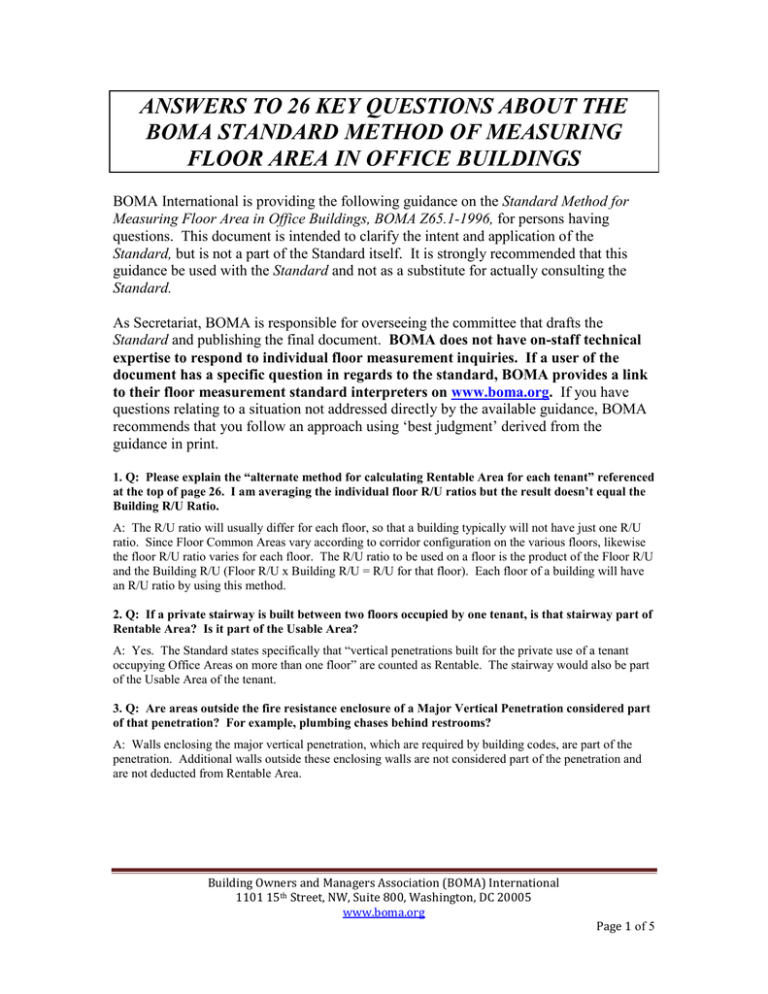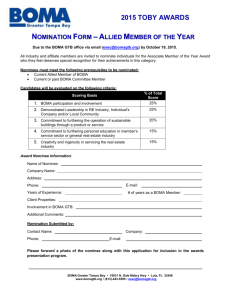answers to 26 key questions about the ansi/boma standard method
advertisement

ANSWERS TO 26 KEY QUESTIONS ABOUT THE BOMA STANDARD METHOD OF MEASURING FLOOR AREA IN OFFICE BUILDINGS BOMA International is providing the following guidance on the Standard Method for Measuring Floor Area in Office Buildings, BOMA Z65.1-1996, for persons having questions. This document is intended to clarify the intent and application of the Standard, but is not a part of the Standard itself. It is strongly recommended that this guidance be used with the Standard and not as a substitute for actually consulting the Standard. As Secretariat, BOMA is responsible for overseeing the committee that drafts the Standard and publishing the final document. BOMA does not have on-staff technical expertise to respond to individual floor measurement inquiries. If a user of the document has a specific question in regards to the standard, BOMA provides a link to their floor measurement standard interpreters on www.boma.org. If you have questions relating to a situation not addressed directly by the available guidance, BOMA recommends that you follow an approach using ‘best judgment’ derived from the guidance in print. 1. Q: Please explain the “alternate method for calculating Rentable Area for each tenant” referenced at the top of page 26. I am averaging the individual floor R/U ratios but the result doesn’t equal the Building R/U Ratio. A: The R/U ratio will usually differ for each floor, so that a building typically will not have just one R/U ratio. Since Floor Common Areas vary according to corridor configuration on the various floors, likewise the floor R/U ratio varies for each floor. The R/U ratio to be used on a floor is the product of the Floor R/U and the Building R/U (Floor R/U x Building R/U = R/U for that floor). Each floor of a building will have an R/U ratio by using this method. 2. Q: If a private stairway is built between two floors occupied by one tenant, is that stairway part of Rentable Area? Is it part of the Usable Area? A: Yes. The Standard states specifically that “vertical penetrations built for the private use of a tenant occupying Office Areas on more than one floor” are counted as Rentable. The stairway would also be part of the Usable Area of the tenant. 3. Q: Are areas outside the fire resistance enclosure of a Major Vertical Penetration considered part of that penetration? For example, plumbing chases behind restrooms? A: Walls enclosing the major vertical penetration, which are required by building codes, are part of the penetration. Additional walls outside these enclosing walls are not considered part of the penetration and are not deducted from Rentable Area. Building Owners and Managers Association (BOMA) International 1101 15th Street, NW, Suite 800, Washington, DC 20005 www.boma.org Page 1 of 5 4. Q: How are “enclosing walls” defined in conjunction with Major Vertical Penetrations? What about the floor of the stair tower or the elevator pits of the elevator shaft? A: The term “enclosing walls” refers to those walls required by building code, and not to the architectural or decorative treatments of those walls. The floor of a stair tower and the pits of the elevator shaft, when found inside the enclosing walls, are part of the Major Vertical Penetration. However, if an area is not within the enclosing walls (such as a storage room under the stair tower), the area is part of the Rentable Area. 5. Q: Regarding ‘Dominant Portion’... where a wall meets a column (such as in the illustration on page 7), a ‘bite’ appears to be taken out of the column as the measurement line shifts. If the column is not square, how are the dimensions of the ‘bite’ determined? A: Columns are not considered in the Standard. Therefore, where a column interrupts the Dominant Portion, the Dominant Portion that exists on each side of the column continues through one-half of the horizontal distance of the column. Where a column interrupts a Dominant Portion that is the same on both sides, the Dominant Portion continues through the column as if the column did not exist. Where a column interrupts a Dominant Portion that is different on each side, the Dominant Portion on one side continues for one-half the horizontal distance and then either steps in or out to meet the Dominant Portion from the other side. 6. Q: Are Major Vertical Penetrations included in Store Area? No -- Major Vertical Penetrations are excluded when calculating Store Area. Rentable Area itself excludes Major Vertical Penetrations -- and, since store area is less than or equal to Floor Rentable Area on the floor where the store is located, Store Area likewise will exclude Major Vertical Penetrations. 7. Q: Are “areas of refuge” (mainly a feature of Canadian buildings) deducted as Major Vertical Penetrations? A: If the area of refuge is not isolated from the stairwell, then it is part of the Major Vertical Penetration and deducted as such. If the area of refuge is isolated from the stairwell with its own set of doors, then it is part of Floor Rentable Area and distributed to each Office Area through the application of the R/U Ratio. 8. Q: If a Store Area is on a corner, is the measurement taken to the building line on both sides? Does it matter whether entrances to the space are located on both sides? A: Store Area requires a street frontage and a ground level. It is possible for a square building to meet these conditions on every one of its sides. In that situation and on that level, the Dominant Portion would be the building line on each side. However, the sides do not have to be at the same level. A building can have street frontage and ground level on one side (e.g., Floor 1) and street frontage and ground level (e.g., on Floor 3). Each of those two floors would be considered Store Area, and the Dominant Portion would be the building line. Having a separate street entrance for the space is not a requirement in determining street frontage for a Store Area. 9. Q: How is building line defined where the ground floor building face is set back further than the upper floors from the street frontage? A: The Standard is intended to measure space that is fully enclosed. Therefore the building line, as used in the Standard to determine Store Area, is the outside face of the column line (or the exterior building surface if columns are not present) of the ground floor on the street frontage exposure. Deviations to the building line, including projections or recesses, are ignored unless they are part of the permanent building exterior of the ground floor. Building Owners and Managers Association (BOMA) International 1101 15th Street, NW, Suite 800, Washington, DC 20005 www.boma.org Page 2 of 5 10. Q: Is a courtyard included in Building Common Area if it is enclosed by four sides but not a roof? (See reference to “fully enclosed courtyard outside the exterior walls” at top of page 3 of the Standard and illustration on page 19.) A: “Fully enclosed” refers to an enclosed space where environmental conditions are maintained by a heating, ventilating and air conditioning system. So there must be a roof in order for the courtyard to be fully enclosed. 11. Q: On an above-ground floor, can a corridor that is ordinarily Floor Common Area be assessed to a particular tenant if it provides the only access to their space? Similarly, can a portion of a ground floor lobby that is ordinarily part of Building Common Area be assessed to a particular tenant if it provides the only access to their space? A: Corridors by their nature typically provide the only access to an office or store, even when the corridor is required primarily for fire egress. The Standard allows, on page 16, that "Where alcoves, recessed entrances or similar deviation from the corridor line are present..." they may be part of the Usable Area, just like the space would have been if the deviation had not occurred. You should first determine whether the suite entrance could be positioned to incorporate the area in question without obstructing other occupants, fire egress, or other building services, before deciding that the area belongs to the Usable Area of an office or store. Remember that no area can be accounted for more than once. If an area belongs to the Usable Area of an office or store, it must be excluded from Floor Common Area, Building Common Area, or the Usable Area of any other office or store. 12. Q: Can a mechanical room serving tenants on an above-ground floor be part of Building Common Area? A: Yes, if it is not already part of a Floor Common Area. 13. Q: Does the Standard measure space on below-ground floors? A. Yes, except for those areas specifically excluded by the Standard, such as parking areas. 14. Q: Is storage space part of Building Common Area in a multi-tenant building? Is storage space Usable if it is for the express use of a given tenant? A: Areas that are used for storage, whether above or below grade, are measured just like an Office (or Store in the cases of street frontage), because these spaces could house tenants' personnel, furniture, files or supplies. If the space is a common storage area available for use by all tenants at no additional charge, than it would be calculated under Building Common Area. If it is for the express use of a given tenant, the storage space would have both a Usable and Rentable measurement. 15. Q: Is parking ever counted as Rentable? A: No, the Standard excludes parking space. 16. Q: If a tenant expands its Rentable Area, does the Floor R/U Ratio and Building R/U Ratio change as a result -- meaning that each tenant’s Rentable Area would change? A: Tenant expansion and new tenant activity may indeed affect the Floor R/U Ratio and/or Building R/U Ratio. If tenant expansion or new tenant activity occurs in part or all of an existing Store Area or Office Area, the ratios remain unchanged. However, if tenant expansion or new tenant activity incorporates what had been Floor Common Area or Building Common Area into the newly created Store or Office Area -- or creates additional Floor Common Area or Building Common Area from what was previously Store or Office Area -- then one or both ratios will be affected. Building Owners and Managers Association (BOMA) International 1101 15th Street, NW, Suite 800, Washington, DC 20005 www.boma.org Page 3 of 5 The Floor R/U Ratio will change if Floor Common Area is increased or decreased (e.g., by changing the configuration of floor circulation corridors or enlarging a restroom). The Building R/U Ratio will change if Building Common Area is increased or decreased (e.g., by leasing an exercise room) or if the Floor R/U Ratio is adjusted on a floor containing Building Common Area. Changes to the Floor R/U Ratio and Building R/U Ratio will affect the Rentable Area of all the offices or stores located on that floor or in the building. For purposes of stability, adjustments to existing leases based on changes to Rentable Area are typically not made, although the new ratios are used in future lease transactions. 17. Q: Regarding the illustration on page 16 of the Standard... Is the measurement taken to the center line of partitions between adjoining tenant spaces and to the center line of partitions between tenant spaces and Building Common Areas? A: Yes. The measurement is taken to the center line of partitions between adjoining Office Area(s) or Store Area(s), Building Common Area(s) and the Building Common Area being measured. Building Common Area is measured just like Office or Store Area in determining Usable Area. 18. Q: It is stated in the Standard (on page 14) that “Building Common Areas are considered to be part of Floor Usable Area.” Can this possibly mean that the Building Common Areas on a groundlevel floor (see the illustration on page 22) are to be measured twice? No -- the Standard does not allow the same space to be measured twice. The illustration on page 14 shows all the area that is part of the Floor Usable Area, which includes both Store Area and Building Common Area. Similar to the illustration on page 20 that deals specifically with Store Area and how it is measured, the illustration on page 22 highlights Building Common Area. Illustrations on page 20 and 22 are components of the Floor Usable Area for the ground-level floor. Together they are the Floor Usable Area illustrated on page 14. The intent of the Standard is for Building Common Area to be part of the Floor Usable Area. Building Common Area needs to take part of the Floor Common Area allocation on the floor(s) on which the Building Common Area is located. Building Common Area, just like Store Area and Office Area, benefits from the circulation corridors and other Floor Common Areas. This allocation is necessary in order to fairly distribute the Floor Common Area to the users. If the allocation was not made, occupants on floors with Building Common Area would receive an unfair higher allocation of Floor Common Area. 19. Q: Why isn’t the exercise club (area #14) and restaurant (area #19) part of Building Common Area as illustrated on page 22 if they are serving the entire building? A: These areas represent rent-paying tenants -- so while they do provide a service to the entire building (indeed to any paying customer), they are Store Area rather than Building Common Area. However, if these areas were a building amenity that all tenants could use as part of their lease, then they would be considered Building Common Area instead. 20. Q: In an office complex, would mechanical areas located in one building -- but which serve others as well -- be considered Building Common Area? What about underground corridors that link one building with another? A: Although the Standard does not deal specifically with building complexes, it would be a reasonable adaptation to consider the entire project as one building and to allocate the common corridors and building mechanical area as allowed through Building Common Area. Building Owners and Managers Association (BOMA) International 1101 15th Street, NW, Suite 800, Washington, DC 20005 www.boma.org Page 4 of 5 21. Q: Is atrium space measured by the Standard? A: Atrium space above the main lobby floor does not constitute Rentable Area. It is empty space and is treated, in effect, as a Major Vertical Penetration. The base of the atrium, however (i.e., the finished floor) is measured. 22. Q: Are mezzanines measured by the Standard? A: All floor space in a building is measured, including mezzanines. The purpose of the Standard is to measure the actual square feet contained in the building. The usefulness of a particular space is not addressed by the Standard, and is better left for lease negotiations between Landlord and Tenant. Varying lease rates are common in the market using such criteria as location on the floor, proximity to the elevator lobby, windows, views, height in the building, and the usefulness of a particular space. 23. Q: On a single tenant floor, are the elevator lobby and restrooms considered Usable Area? A: The BOMA Standard defines Usable Area as space that tenants can actually occupy and use and may allocate to house personnel and furniture. Thus, if an elevator lobby is under the tenant’s control and could be put to use (as a reception area, for instance), it is Usable Area. However, if the tenant cannot use that space because of fire code or other restrictions, it is not Usable Area. Restrooms are not considered Usable Area under the Standard, although they are part of Rentable Area. 24. Q: Is Gross Building Area an appropriate way to measure a single occupant building? A: The Standard is a systematic method for measuring office buildings, and should be used in its entirety for each building. Its purpose is to provide a common and agreed-upon basis for comparing lease rates, building efficiencies, operating costs and other relevant data. For example, Gross Building Area is used within the industry primarily to determine construction costs or building value. Usable Area is often used to determine cleaning costs and space efficiencies. Single occupant buildings will often need to be compared to multi-occupant buildings and, in these cases, Building Rentable Area is the recommended measurement to use. Gross Building Area is an appropriate method in determining a single tenant lease rate. Each part of the Standard has its own use and needs to be applied regardless of the number of occupants. 25. Q: Does the Standard provide for the measurement of warehouse or industrial space? Does it cover a shopping center or strip mall? A: The Standard is intended to apply specifically to the measurement of office buildings. A method for measuring Store Area in office buildings is contained in the Standard. No provision is currently made for measuring any other types of buildings. 26. Q: Does BOMA ‘certify’ space measurement firms or instruments? A: BOMA does not certify, approve, or endorse any space measurement firm or measurement device. Building Owners and Managers Association (BOMA) International 1101 15th Street, NW, Suite 800, Washington, DC 20005 www.boma.org Page 5 of 5



